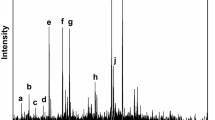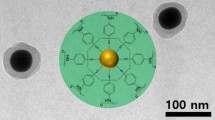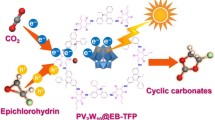Abstract
The stability and electronic properties of gold and silver nanowires (NWs) containing up to 12 atoms trapped inside cyclo[8]thiophenes (CT8) nanoaggregates have been modeled using M06 functional, 3-21G* basis set for nonmetallic atoms; LANL2DZ pseudopotential basis set for metals were applied for optimization; and 6-31G* and LANL2DZ basis sets for single point calculations, respectively. It has been found that the formation of (NW) inside CT8 nanoaggregates is a thermodynamically favorable process and it could be a potentially useful method of metal NW stabilization. The inclusion of metal NW inside CT8 nanoaggregates increases significantly the binding energy between macrocycles and changes the geometry of NW compared to that of free-standing clusters due to the size restriction imposed by the nanoaggregate cavity. The binding energies per metal atom reach a maximum for three metal atoms and then start decreasing with a possible stabilization for large NW. It was found that the binding energies between silver NW and CT8 nanoaggregate are lower than those of gold NW and that in the case of gold NW containing more than four metal atoms the S0 → S1 excitation involves almost exclusively electrons of metal NW. On the other hand, in the case of silver NW the excitation involves the electron transfer from the NW to the CT8 nanoaggregate.








Similar content being viewed by others
References
Ajayan PM, Iijima S (1993) Capillarity-induced filling of carbon nanotubes. Nature 361:333–334. doi:10.1038/361333a0
Baetzold RC (1971) Calculated properties of metal aggregates. I. Diatomic molecules. J Chem Phys 55:4355–4363. doi:10.1063/1.1676760
Brandbyge M, Mozos J-L, Ordejón P, Taylor J, Stokbro K (2002) Density-functional method for nonequilibrium electron transport. Phys Rev B 65:165401. doi:10.1103/PhysRevB.65.165401
Burghard M (2005) Electronic and vibrational properties of chemically modified single-wall carbon nanotubes. Surf Sci Rep 58:1–109. doi:10.1016/j.surfrep.2005.07.001
Carroll RL, Gorman CB (2002) The genesis of molecular electronics. Angew Chem Int Ed 41:4378–4400. doi:10.1002/1521-3773(20021202)41:23
Dadosh T, Gordin Y, Krahne R, Khivrich I, Mahalu D, Frydman V, Sperling J, Yacoby A, Bar-Joseph I (2005) Measurement of the conductance of single conjugated molecules. Nature 436:677–680. doi:10.1038/nature03898
Flores P, Guadarrama P, Ramos E, Fomine S (2008) Tubular aggregates of cyclic oligothiophenes. A theoretical study. J Phys Chem A 112:3996–4003. doi:10.1021/jp710654k
Fournier R (2001) Theoretical study of the structure of silver clusters. J Chem Phys 115:2165–2177. doi:10.1063/1.1383288
Frisch MJ et al (2009) Gaussian 09, revision B.01. Gaussian, Inc., Wallingford
Fuhrmann G, Debaerdemaeker T, Bäuerle P (2003) C–C bond formation through oxidatively induced elimination of platinum complexes—a novel approach towards conjugated macrocycles. Chem Commun 948–949. doi:10.1039/B300542A
Grobert N, Terrones M, Osborne AJ, Terrones H, Hsu WK, Trasobares S, Zhu YQ, Hare JP, Kroto HW, Walton RM (1998) Thermolysis of C60 thin films yields Ni-filled tapered nanotubes. Appl Phys A 67:595–598
Grobert N, Hsu WK, Zhu YQ, Hare JP, Kroto HW, Walton DRM, Terrones M, Terrones H, Redlich Ph, Rühle M, Escudero R, Morales F (1999) Enhanced magnetic coercivities in Fe nanowires. Appl Phys Lett 75:3363–3365. doi:10.1063/1.125352
Guerret-Piécourt C, Le Bouar Y, Loiseau A, Pascard H (1994) Relation between metal electronic structure and morphology of metal compounds inside carbon nanotubes. Nature 372:761–765. doi:10.1038/372761a0
Hirsch A, Vostrowsky O (2005) Functionalization of carbon nanotubes top. Curr Chem 245:193–237. doi:10.1007/b98169
Hsin YL, Hwang KC, Chen FR, Kai JJ (2001) Production and in situ metal filling of carbon nanotubes in water. Adv Mater 13:830–833. doi:10.1002/1521-4095(200106)13:11
Hu J, Bando Y, Zhan J, Zhi C, Golberg D (2006) Carbon nanotubes as nanoreactors for fabrication of single-crystalline Mg3N2 nanowires. Nano Lett 6:1136–1140. doi:10.1021/nl060245v
Ivanovskaya VV, Makurin YuN, Ivanovskii AL (2005) Fullerene peapods and related nanomaterials: synthesis, structure and electronic structure. In: Diudea M (ed) Nanostructures: novel architectures. Nova Science Publishers, New York, pp 9–24
Kondo Y, Takayanagi K (2000) Synthesis and characterization of helical multi-shell gold nanowires. Science 289:606–608. doi:10.1126/science.289.5479.606
Kubatkin S, Danilov A, Hjort M, Cornil J, Brédas J-L, Stuhr-Hansen N, Hedegård P, Bjórnholm T (2003) Single-electron transistor of a single organic molecule with access to several redox states. Nature 425:698–701. doi:10.1038/nature02010
Leonhardt A, Ritschel A, Kozhuharova R, Graff A, Mühl T, Huhle R, Mönch I, Elefant D, Schneider CM (2003) Synthesis and properties of filled carbon nanotubes. Diam Relat Mater 12:790–793. doi:10.1016/S0925-9635(02)00325-4
Loiseau A, Pascard H (1996) Synthesis of long carbon nanotubes filled with Se, S, Sb and Ge by the arc method. Chem Phys Lett 256:246–252
Martin RL (2003) Natural transition orbitals. J Chem Phys 118:4775–4777. doi:10.1063/1.1558471
Seminario JM, Zacarias AG, Tour JM (2000) Theoretical study of a molecular resonant tunneling diode. J Am Chem Soc 122:3015–3020. doi:10.1021/ja992936h
Setlur AA, Lauerhaas JM, Dai JY, Chang RPH (1996) A method for synthesizing large quantities of carbon nanotubes and encapsulated copper nanowires. Appl Phys Lett 69:345–347. doi:10.1063/1.118055
Soler JM, Artacho E, Gale JD, García A, Junquera J, Ordejón P, Sánchez-Portal D (2002) The SIESTA method for ab initio order—N materials simulation. J Phys Condens Matter 14:2745–2779. doi:10.1088/0953-8984/14/11/302
Song H, Kim Y, Jang YH, Jeong H, Reed MA, Lee T (2009) Observation of molecular orbital gating. Nature 462:1039–1043. doi:10.1038/nature08639
Taylor J, Guo H, Wang J (2001) Ab initio modeling of quantum transport properties of molecular electronic devices. Phys Rev B 63:245407. doi:10.1103/PhysRevB.63.245407
Terrones H, Lopez-Urias F, Munoz-Sandoval E, Rodriguez-Manzo JA, Zamudio A, Elias AL, Terrones M (2006) Magnetism in Fe-based and carbon nanostructures: theory and applications. Solid State Sci 8:303–320
Tour JM (2000) Molecular electronics. Synthesis and testing of components. Acc Chem Res 33:791–804. doi:10.1021/ar0000612
Verhaegen G, Stafford FE, Goldfinger P, Ackerman M (1962) Correlation of dissociation energies of gaseous molecules and of heats of vaporization of solids. Part 1.—Homonuclear diatomic molecules. Trans Faraday Soc 58:1926–1938. doi:10.1039/TF9625801926
Wang J, Wang G, Zhao J (2002) Density-functional study of Au n (n = 2–20) clusters: lowest-energy structures and electronic properties. Phys Rev B 66:035418. doi:10.1103/PhysRevB.66.035418
Yanai T, Tew D, Handy N (2004) A new hybrid exchange–correlation functional using the Coulomb-attenuating method (CAM-B3LYP). Chem Phys Lett 393:51–57. doi:10.1016/j.cplett.2004.06.011
Yu LH, Natelson D (2004) The Kondo effect in C60 single-molecule transistors. Nano Lett 4:79–83. doi:10.1021/nl034893f
Zhao Y, Truhlar DG (2006) A new local density functional for main-group thermochemistry, transition metal bonding, thermochemical kinetics, and noncovalent interactions. J Chem Phys 125:194101. doi:10.1063/1.2370993
Acknowledgments
The authors acknowledge the financial support from CONACYT Mexico (Grant 151277).
Author information
Authors and Affiliations
Corresponding author
Rights and permissions
About this article
Cite this article
Fomine, S. Stabilization of gold and silver nanowires inside cyclo[8]thiophene nanoaggregates: a theoretical study. J Nanopart Res 14, 979 (2012). https://doi.org/10.1007/s11051-012-0979-1
Received:
Accepted:
Published:
DOI: https://doi.org/10.1007/s11051-012-0979-1




